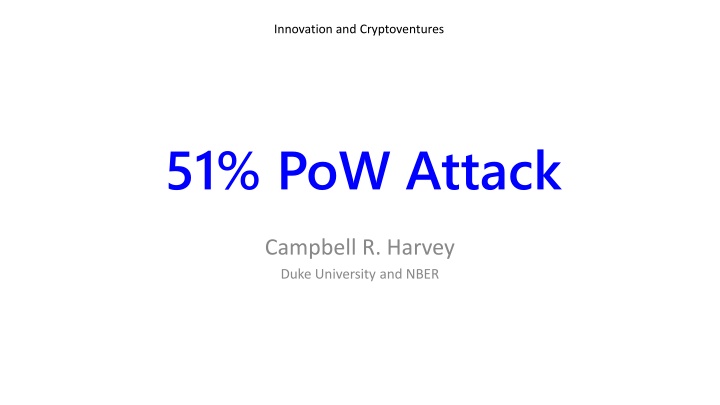
Blockchain Security: 51% Attack and History Rewriting
Explore the concept of a 51% attack in blockchain security and how attackers can rewrite transaction history. Learn how the network determines which chain to follow and the role of cumulative proof of work in maintaining blockchain integrity.
Download Presentation

Please find below an Image/Link to download the presentation.
The content on the website is provided AS IS for your information and personal use only. It may not be sold, licensed, or shared on other websites without obtaining consent from the author. If you encounter any issues during the download, it is possible that the publisher has removed the file from their server.
You are allowed to download the files provided on this website for personal or commercial use, subject to the condition that they are used lawfully. All files are the property of their respective owners.
The content on the website is provided AS IS for your information and personal use only. It may not be sold, licensed, or shared on other websites without obtaining consent from the author.
E N D
Presentation Transcript
Innovation and Cryptoventures 51% PoW Attack Campbell R. Harvey Duke University and NBER
The warning https://bitcoin.org/bitcoin.pdf Campbell R. Harvey 2019 3 Published on Internet November 2008
The warning Electronic payment system P2P No double spending Secure via hash Longest chain Warning about 51% attack https://bitcoin.org/bitcoin.pdf Published November 2008 Campbell R. Harvey 2019 4
Setting Attacker (A) amasses 51% of hashing power in PoW blockchain Attacker acquires something and pays 100 BTC to B This transaction is valid and is eventually confirmed by entering block 10 Important that the attacker has collected the goods from B Campbell R. Harvey 2019 5
Rewriting history Attacker uses 51% of hashing power to rewrite history Suppose we are now on block 12 Attacker redoes block 10 by changing the transaction: instead of paying 100BTC to B, attacker pays 100BTC to herself (at the time of block 10, this would be a valid transaction). Coinbase transaction (reward to miner) is also changed. Attacker also must redo block 11 because of the hash link is different. Attacker may keep all of the transactions in block 11 (change the coinbase transaction) Attacker is now working on their version of block 12 Campbell R. Harvey 2019 6
Rewriting history There are two chains now There is the original chain 1-11 (we are working on 12) There is the attacker s chain 1-11 (blocks 1-9 are common with the original chain) How does the network know what one to use? That is, what triggers the replacement of blocks 10-12 (assuming the attacker finishes block 12 before the rest of the miners)? Campbell R. Harvey 2019 7
Rewriting history Cumulative proof of work best chain rule Any node that receives a different VALID chain of blocks (that don't break any protocol rules) will reorganize its perspective of the blockchain to use the new chain of blocks if and only if the cumulative proof of work securing that chain of blocks is greater than the cumulative proof of work securing the chain it currently believes to be the best.* Campbell R. Harvey 2019 8 Thanks to bitcoin developer Jameson Lopp for these details
Achieving the hack Bitcoin s difficulty only adjusts every 2,016 blocks The attacker has 51% of the mining power whereas other miners have only 49% This means that the attacker will be able to add blocks faster than rest of miners Eventually, attacker will have one extra block than the rest: For example, attacker has a chain 1-20 whereas the rest have a chain 1-19 Campbell R. Harvey 2019 9
Achieving the hack Longest chain Once you have the longest chain, you broadcast your newest block (say block 20) to the nodes Nodes will see it is valid and automatically request the missing blocks 10-19 to backfill them The nodes will recognize the attacker s version of the blockchain because it is the higher cumulative proof of work (because it has one extra block) In this particular case (where difficulty is the same for a long stretch of blocks), the longest chain wins Campbell R. Harvey 2019 10
Other issues Empty blocks Attacker posts blocks that include no transactions in the memory pool of pending transactions The only transaction is the coinbase transaction to the attacker This means that the memory pool will get large and it will take a long time to confirm transactions It might be that new transactions start to come in at a faster rate than they can be put in blocks This would lead people to lose confidence in the system Campbell R. Harvey 2019 11
Other issues Spamming mempool Flood mempool with millions of 1 satoshi transactions This is less feasible today because these transactions would be ignored because they don t include transactions fees Campbell R. Harvey 2019 12
Other issues Involuntary promotion of mempool spamming Coinbase, Blockchain, and Genesis have been causing significant congestions by not batching their transactions Coinbase.com is working on a solution (moving to SegWit) Campbell R. Harvey 2019 13
Blockchain vs. exchanges Hacking an exchange is completely different Hacks of CoinCheck, Bitfinex and Mt Gox do not involve blockchain hacking they simply reflect the lack of security on these exchangers Campbell R. Harvey 2019 14
Other ways to attack There are many other ways to attack https://en.bitcoin.it/wiki/Irreversible_Transactions presents a list of attack vectors (that includes the majority attack ) Campbell R. Harvey 2019 15
Recommended Reading There are many other ways to attack https://en.bitcoin.it/wiki/Majority_attack https://medium.com/@fhansmann/demystifying-the-51- consensus-attack-942252090b33 Campbell R. Harvey 2019 16















